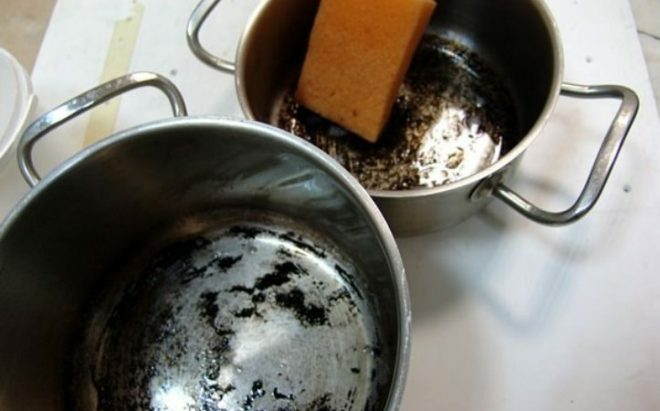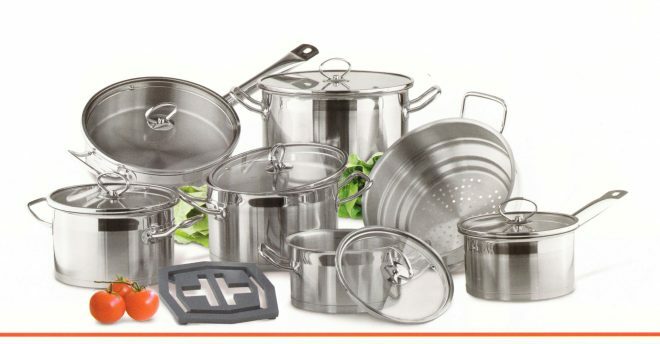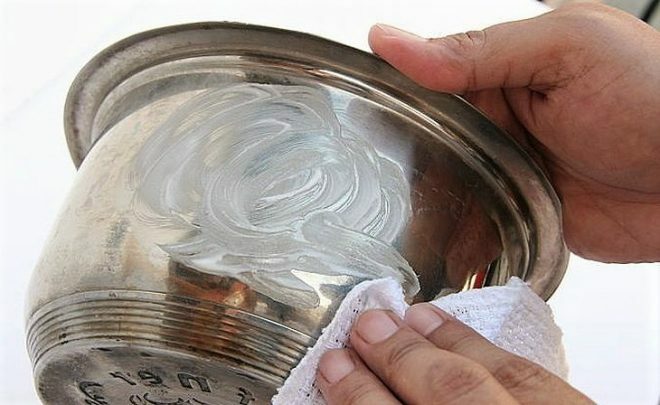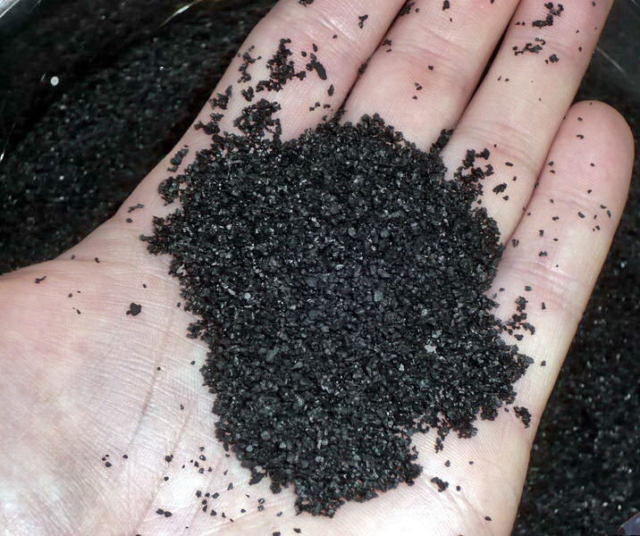Stainless steel pots have taken their pride of place on kitchen shelves and are recognized by almost all housewives and professionals who deal with cooking. But what if it's burnt? How to wash a burnt stainless steel pan, we will tell you in this article.

Convenience and durability of stainless steel pans
The beautiful appearance of the cookware complements the convenience and practicality of use. Such products serve for a very long time, they are quite durable. Even in unfavorable conditions, their surfaces do not deform, do not scratch or chip. These qualities compete with the old familiar pans made of enamel or aluminum. And transparent lids make it possible to control the cooking process. Another significant plus of stainless steel dishes is that at any temperature their handles do not heat up, which you often have to grasp with your hands when preparing food.
Attention! Earned on our website kitchen designer. You can familiarize yourself with it and design your dream kitchen for free! May also come in handy wardrobes designer.

They have a heavy, multilayered bottom, which prevents food from burning and helps to keep the temperature of the cooked food for a long time. The material from which such dishes are made is considered environmentally friendly, since microbes do not accumulate on the smooth and polished surface. Stainless steel does not enter into a chemical reaction with food, so cooked food is completely safe for the body.
A stainless steel pan is burnt - how to clean it from carbon deposits?
It is recommended to clean any utensils regularly. So it will be easier and faster to wash, having served for many more years. Since pots are made from different materials, the cleaning methods also differ. And every housewife should know the "special secrets" of how to clean this or that thing.
This steel contains chromium. Interacting with air, it forms a film that serves as a protective layer for metal against rust. Carbon deposits, grease and other contaminants prevent this reaction, therefore it is advisable to clean the dishes at the first contamination.
Traditional methods of cleaning inside and out
Today there are many different detergents for cleaning stainless steel dishes. And here it is important to choose not only an effective method, but also a safe one. It must be remembered that when using aggressive cleaning agents, stains may appear on the stainless steel, which will spoil the appearance of the dishes.

Another unwanted tool when cleaning stainless material is metal scouring pads, which leave small scratches on the sides of the pot. For this purpose, it is better to use a soft washcloth or napkin, cleaning the dishes in smooth circular motions. If a washing machine is used to wash a burnt stainless steel pan, then it is better to pre-soak the resulting carbon deposits. Any carbon deposits or grease on stainless steel are not recommended to be scraped off with sharp objects. The method of soaking or boiling is more suitable here.
As an alternative to chemicals, there are always proven folk methods. They are safer, more economical and the necessary means for them can be found in any home.
The heating
Sometimes, to clean a burnt pan of stainless steel carbon deposits, you can do without any tools at all. It is often enough to simply heat it up and remove the dirt with a sponge.
Boiling is a quick way to clean the bottom of a stainless steel pot
Boiling is an effective and easy way to clean. Various agents are added to a pot of water and boiled. Here are some of these options:
- Add salt to boiling water. It should be remembered that salt must be added to boiling water, not earlier.
- Add baking soda and detergent to a bowl of water. Boil the mixture for several minutes.
To clean the carbon deposits from the outside, you need to use another dish, larger in volume. Pour water and vinegar essence 70-80% in equal parts into it, heat the mixture until steam appears. Soiled dishes should be kept over steam for about 10 minutes. After that, moisten a napkin in a vinegar solution, dip it in a mixture of soda and salt, rub the places with carbon deposits. It is best to use gloves to avoid damaging your hands.
Purification with activated carbon

This tool is in almost every home medicine cabinet. Moreover, you can use both traditional black coal and white, which is popular today. Several packs of tablets must be crushed into powder, apply the required amount on a wet napkin, wipe off the dirt in a circular motion. If the carbon deposit is more complex, then gruel from the same tablets and water will help. Such a paste should be applied to the contaminated areas and left for 20-30 minutes, then rinsed with warm water.
Since activated carbon is absolutely safe for human health, this method can be used to clean both the outer surface and the inner one.
Milk serum
This versatile product is suitable for pots made of any material: enamel, aluminum and stainless steel. Milk whey contains a lot of acids and alkalis, which effectively fight carbon deposits. It is necessary to fill the burnt place with serum so that it completely covers the dirt. In this state, you need to leave the dishes for a day. Then wash with a regular sponge and dishwashing detergent.
Cleansing with baking soda and vinegar
To use soda to clean the carbon deposits on stainless steel, you need a large container. Pour water into it and add soda in the proportion: per liter of water 2-3 tbsp. l. soda. Place dirty dishes in a container with a solution and bring to a boil. Simmer for about two hours. After this procedure, the carbon deposits are easily cleaned.
The second way to remove carbon deposits from stainless steel using soda is soda gruel. First, you need to remove all food debris from the pan that is not stuck and easily come off. Then apply a layer of soda to the remaining dirt. Dry baking soda does not adhere well to the walls of the dishes, so you need to moisten either the baking soda or the pan itself. After applying the gruel, leave the pan for several hours, then rinse with running water.
When handling vinegar, it is best to use rubber gloves to protect your hands. Vinegar is applied to the carbonized areas with a sponge dipped in this product. You can not spare vinegar. The exposure time is 2-3 hours, while the pan should be covered with a lid. After the procedure, wash the pan with detergent, rinse under running water and dry. Citric acid or fresh lemon juice can be used instead of vinegar.
Laundry soap
This method is suitable for light soiling. If carbon deposits have formed inside the pan, fill it with water, add grated laundry soap. Boil the composition over low heat for 20 minutes. If you need to remove carbon deposits on the outer walls of the pan, then again you will need larger dishes. The container is filled with water and soap shavings, and dirty dishes are placed in the water. It takes the same amount of time to boil. After this procedure, the carbon deposits noticeably soften, it is easy to remove it with a sponge. Use a scraper carefully if necessary.
Citric acid - quick cleansing (video)
Burnt out? How to clean with household chemicals
Please be aware that not all carbon removers are suitable for stainless steel cookware. You need to choose a drug designed specifically for stainless steel. These are gentle compounds that do not contain chlorine and abrasive substances. Apply according to the instructions. Or, apply the agent to the dirt, after 10-15 minutes, clean the carbon deposits with a sponge, wipe the pan dry. In order to get rid of carbon deposits inside the dishes, you just need to fill it with water and detergent and boil for 15 minutes.
General tips for caring for your stainless steel pot
So that stainless steel dishes serve for a long time, delight the eye with their brilliance, and cooking in it gave only pleasure, you need to know the basic rules of care - what can be used and what is categorically is prohibited.
- Use cleaning powders and products intended strictly for stainless steel.
- Clean with kitchen scouring pads or microfiber cloths.
- Temperature extremes negatively affect the condition of stainless steel pots. You should not pour hot water into a cold saucepan, or vice versa.
- For a radiant shine, rub the surface with a wedge of freshly peeled raw potatoes. The same effect can be achieved with vinegar.
- Stubborn stains can be easily removed with a mixture of toothpaste and ammonia. Wet a napkin with the composition and wipe off the stains. Wash the dishes with cold water.
- If possible, do not use the dishwasher.
- Do not use steel brushes and brushes, metal sponges. It is also undesirable to use polishing pastes.
- Wipe the surface of the pot and lid dry after each cleaning.
Video: how to clean a burnt stainless steel pan
By observing these simple rules, stainless steel cookware will retain its perfect shine for a long time.
average rating 0 / 5. Number of ratings: 0
No ratings yet. Be the first to rate.


